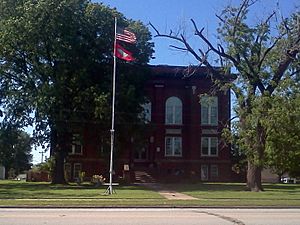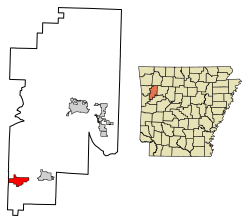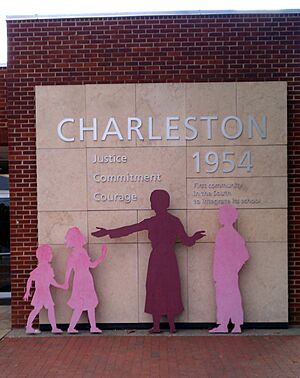Charleston, Arkansas facts for kids
Quick facts for kids
Charleston, Arkansas
|
|
|---|---|

Franklin County Courthouse, Southern District
|
|

Location of Charleston in Franklin County, Arkansas.
|
|
| Country | United States |
| State | Arkansas |
| County | Franklin |
| Area | |
| • Total | 3.94 sq mi (10.21 km2) |
| • Land | 3.83 sq mi (9.93 km2) |
| • Water | 0.11 sq mi (0.28 km2) |
| Elevation | 485 ft (148 m) |
| Population
(2020)
|
|
| • Total | 2,588 |
| • Density | 675.01/sq mi (260.62/km2) |
| Time zone | UTC-6 (Central (CST)) |
| • Summer (DST) | UTC-5 (CDT) |
| ZIP code |
72933
|
| Area code(s) | 479 |
| FIPS code | 05-13300 |
| GNIS feature ID | 2404028 |
Charleston is a city located in Franklin County, Arkansas, in the United States. It's one of two county seats for Franklin County, sharing this role with Ozark. Charleston is also part of the larger Fort Smith, Arkansas-Oklahoma area. In 2020, about 2,588 people lived there.
Contents
A Look at Charleston's Past
Charleston was officially mapped out in 1870. This means its streets and lots were planned.
School Integration History
Charleston made history in 1954. It was the first school district in the former Confederate States to integrate its schools. This happened after the important Brown v. Board of Education court case. This case said that separate schools for different races were not fair.
On July 27, 1954, the school board voted to allow all children to attend the same schools. This included 11 black children who joined 480 white students on August 23. The school superintendent worked with local news not to make a big story of it. This helped the change happen smoothly.
Integrating schools also had financial benefits for the district. They no longer had to pay to bus black high school students to Fort Smith. They could also close the old Rosenwald school, which was a school for black children.
During the Civil Rights Movement, Charleston was one of the few Southern cities that integrated with little trouble. However, the city did face some challenges. Other schools sometimes refused to play sports against Charleston. The school band was also not allowed to play in some competitions. In 1961, Barbara (Williams) Dotson and Joe Ferguson became the first two black students to graduate from Charleston High School.
Where is Charleston Located?
Charleston is in the southwestern part of Franklin County. It is located along Arkansas Highway 22. This highway goes east about 9 miles to Ratcliff. It also goes west about 24 miles to Fort Smith.
Land and Water
According to the United States Census Bureau, Charleston covers a total area of about 3.94 square miles (10.21 square kilometers). Most of this area is land, about 3.83 square miles (9.93 square kilometers). A small part, about 0.11 square miles (0.28 square kilometers), is water.
Who Lives in Charleston?
| Historical population | |||
|---|---|---|---|
| Census | Pop. | %± | |
| 1880 | 393 | — | |
| 1890 | 370 | −5.9% | |
| 1910 | 576 | — | |
| 1920 | 734 | 27.4% | |
| 1930 | 851 | 15.9% | |
| 1940 | 958 | 12.6% | |
| 1950 | 968 | 1.0% | |
| 1960 | 1,036 | 7.0% | |
| 1970 | 1,497 | 44.5% | |
| 1980 | 1,748 | 16.8% | |
| 1990 | 2,128 | 21.7% | |
| 2000 | 2,965 | 39.3% | |
| 2010 | 2,494 | −15.9% | |
| 2020 | 2,588 | 3.8% | |
| U.S. Decennial Census 2014 Estimate |
|||
2020 Population Details
In 2020, Charleston had 2,588 people living in the city. There were 997 households and 639 families.
The table below shows the different groups of people living in Charleston in 2020:
| Group | Number of People | Percentage |
|---|---|---|
| White (not Hispanic) | 2,280 | 88.1% |
| Black or African American (not Hispanic) | 23 | 0.89% |
| Native American | 34 | 1.31% |
| Asian | 9 | 0.35% |
| Other/Mixed | 171 | 6.61% |
| Hispanic or Latino | 71 | 2.74% |
Education in Charleston
The Charleston School District offers public education for students from kindergarten through 12th grade. The district has three main schools:
- Charleston High School for grades 9–12
- Charleston Elementary School for grades K–4
- Charleston Middle School for grades 5–8
As mentioned earlier, the Charleston School District was the first in the former Confederate States to integrate its schools. This was a very important step in the history of education. The old high school building was taken down in 2010 to make space for a larger middle school. There is a small monument in front of Charleston Middle School today. It honors the school's role in integration.
Famous People from Charleston
Many notable people have come from Charleston, Arkansas. Here are a few:
- John "Tree" Adams – A former American football player for the Washington Redskins.
- Betty Bumpers – A politician.
- Dale Bumpers – A former governor of Arkansas and U.S. senator from Arkansas.
- DeRosey Caroll Cabell – An Army General.
- Paula Casey – A United States Attorney.
- Steve Cox – A former American football player for the Washington Redskins.
- Otis Davis – A baseball player for the Brooklyn Dodgers.
- Denny Flynn – A professional bull rider.
- Francis Irby Gwaltney – An author.
- Larry Lester – A historian, author, and co-founder of the Negro League Baseball Museum.
- Gary Stubblefield – A farmer and politician.
- Jesse G. Vincent – A designer of engines for aircraft, boats, and cars.
See also
 In Spanish: Charleston (Arkansas) para niños
In Spanish: Charleston (Arkansas) para niños


